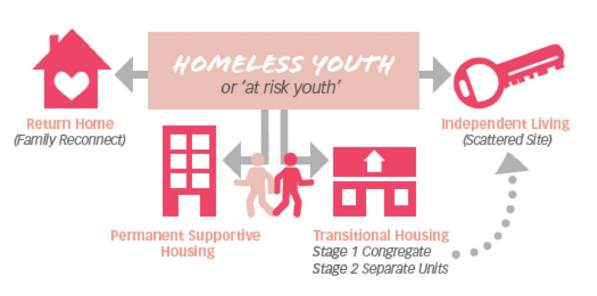In 2013 the Canadian Observatory on Homelessness in collaboration with the Hamilton Street Youth Planning Collaborative and the National Learning Community on Youth Homelessness created a framework for adapting Housing First to meet the developmental needs of young people. A Safe and Decent Place to Live is now used internationally and will soon be the basis for a toolkit of resources to implement the model for service providers everywhere. In order to strengthen the model so it leads to the best possible outcomes for young people, we are currently engaged in a process with international and Canadian stakeholders to refine the framework and build consensus on the model. Our goal is to develop a toolkit of resources that can be adapted in a variety of community and national contexts. If you have the time, watch the recent webinar led by A Way Home and the Canadian Observatory on Homelessness where we walked Canadian and international stakeholders through the framework. There is a rich discussion at the end of the webinar with some experts on Housing First and Housing First for Youth – Dr. Sam Tsemberis, Wally Czech and Katie Davies. If your September looks like mine, you might just want me to break it down for you. Here are the core principles of Housing First for Youth.
- Immediate access to housing with no preconditions
- Youth choice and self-determination
- Positive youth development orientation
- Individualized and client-driven supports
- Social and community integration
One key difference with Housing First for Youth is that young people need a range of housing options. Here are the models of accommodation in the Canadian context.
Here are the types of supports that developing adolescents require.
Core to Housing First for Youth are supports for young people to meaningfully reconnect with natural supports, such as family. You’ll notice above that one of the options for accommodation with this model is returning to the family home or to live with another adult meaningful to the young person. In order to stress the importance of family mediation, or reconnection, we’ve begun using the term “Family First” in Canada (coined by Diane Randall with the City of Lethbridge and evolved by David French with the Government of Alberta). (Family First builds on the pioneering work with family reconnection by organizations like Eva’s and the Boys and Girls Club of Calgary and has a growing evidence base.) Now that doesn’t mean that every young person needs to return home, as it may not be safe or appropriate. What it does mean is that every young person should receive the offer of family mediation/reconnection in order to connect with natural supports.
Housing First for Youth is a human rights-based approach that is a critical tool in our prevention toolbox. We have some national and international examples of using Housing First for Youth to prevent young people exiting systems like foster care and corrections from ever experiencing homelessness. It is also used to prevent young people that are currently experiencing homelessness from ever experiencing homelessness again. As I said, we have some examples, but moving forward it is going to be critical that we build a strong evidence base in order to inform sound public policy and investment on prevention.
Stay tuned for updates as we develop the Housing First for Youth Toolkit and launch a training and technical assistance program on Housing First for Youth in collaboration with the Canadian Alliance to End Homelessness and the Canadian Observatory on Homelessness.
This post is part of a monthly series that follows A Way Home's progress as we create real change on the issue of youth homelessness. On the second Wednesday of every month, join us for an update from A Way Home's Executive Director, Melanie Redman.


